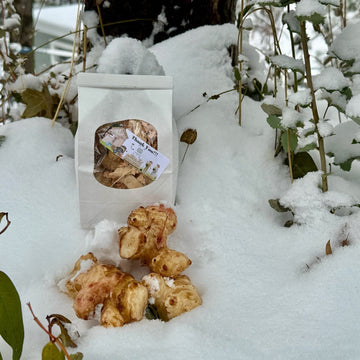
Growing Galangal Rhizomes: A Complete Guide for Your Greenhouse
If you're looking to add a unique, flavorful plant to your greenhouse, consider galangal (Alpinia galanga). A relative of ginger, this aromatic rhizome is a staple in Southeast Asian cuisine, known for its sharp, peppery taste and citrusy aroma. Growing galangal rhizomes can be a rewarding experience, especially when you're able to harvest them fresh for culinary use. Here’s everything you need to know about planting, growing, and harvesting galangal in your greenhouse.
1. Understanding Galangal
Galangal is a tropical plant that thrives in warm, humid conditions, making it well-suited for greenhouse environments. It’s often confused with ginger, but galangal’s flavor profile is distinctly different — it’s spicier, more aromatic, and has a hint of citrus. While galangal can be grown in the ground, it’s perfectly happy in containers, making it a great choice for greenhouse gardening.
2. Planting Galangal Rhizomes
When to Plant
Galangal is best planted in the spring or early summer when temperatures are consistently warm. In a greenhouse, you have the advantage of controlling the climate, which makes it easier to create the perfect growing environment.
Planting Procedure
- Prepare your soil: Galangal prefers well-draining, slightly acidic soil. You can use a mixture of potting soil and compost, or you can plant it directly in the ground if your greenhouse has garden beds.
- Spacing: Space the rhizomes about 6 inches apart. They need room to grow and spread out.
- Depth: Bury the rhizomes about 2–3 inches deep. The buds should face upward, as these will sprout into the plant.
- Containers: If planting in containers, make sure they are large enough (at least 18 inches wide and 12 inches deep) to allow the rhizomes to grow. Use a good-quality, well-draining potting mix.
Ideal Conditions
Galangal needs a warm, humid environment to thrive. Ideally, your greenhouse should maintain temperatures between 70°F and 85°F (21°C to 29°C) during the day. At night, temperatures should stay above 60°F (15°C) to ensure healthy growth. Make sure your greenhouse has good ventilation to prevent excess moisture buildup, which can lead to mold or rot.
3. Caring for Your Galangal Plant
Watering
Galangal needs consistently moist soil, but it does not like to sit in waterlogged conditions. Water the plant regularly, but ensure the soil drains well to prevent root rot. In a greenhouse, the humidity can help, but you’ll still need to monitor the soil moisture closely. Aim to keep the soil damp but not soaking wet.
Fertilizing
Galangal benefits from regular feeding to encourage strong growth. You can apply a balanced, slow-release fertilizer every 4–6 weeks during the growing season. If you're using organic methods, compost or a liquid seaweed fertilizer can provide the necessary nutrients.
Pruning and Maintenance
Remove any dead or yellowing leaves to help maintain plant health. Galangal is a tropical plant, and it can grow quite tall (up to 5 feet or more), so ensure there’s enough space in your greenhouse for it to flourish.
Pest and Disease Management
Galangal is generally resistant to pests, but keep an eye out for aphids or scale insects. A gentle rinse with water or organic insecticidal soap can keep pests under control. If you notice any mold or mildew, increase ventilation in the greenhouse and remove infected plant parts.
4. Harvesting Galangal Rhizomes
When to Harvest
Patience is key when growing galangal. It typically takes 10 to 12 months for the rhizomes to mature, so it’s important to let the plant grow for at least a full year before harvesting. The plant will die back naturally once the rhizomes are ready.
You can check for maturity by gently digging up the rhizomes. They should be firm, healthy, and well-developed. If you’re harvesting for the first time, start by digging up just a portion of the rhizome to leave the rest to continue growing. This way, you can have a continuous supply of galangal.
How to Harvest
- Loosen the soil: Use a garden fork or shovel to carefully loosen the soil around the rhizome. Be careful not to damage the rhizomes as you dig.
- Lift the rhizome: Once the soil is loosened, gently lift the rhizomes from the ground.
- Trim and clean: Cut away any dead or damaged rhizomes and wash the healthy ones thoroughly. You can store fresh galangal rhizomes in the refrigerator or freeze them for later use.
5. Storing Galangal Rhizomes
Fresh galangal rhizomes can be stored in the refrigerator for up to two weeks. For longer storage, you can freeze the rhizomes. Simply peel and chop them into smaller pieces before freezing. Alternatively, you can dry the rhizomes and grind them into a powder for use in cooking.
Conclusion
Growing galangal rhizomes in your greenhouse can be a fun and rewarding experience. With a little attention to temperature, humidity, and soil conditions, you’ll be able to enjoy fresh galangal for your culinary needs. Whether you’re using it in Thai curries, soups, or herbal teas, having a ready supply of homegrown galangal adds a special touch to your cooking.
By following these tips on planting, growing, and harvesting galangal rhizomes, you'll have a thriving, flavorful plant in your greenhouse year after year.
Happy gardening!


